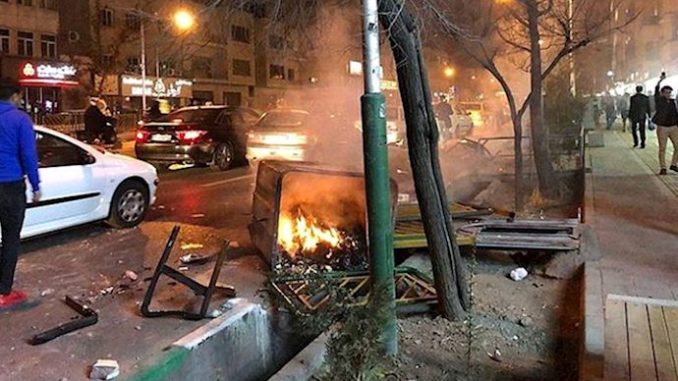
The Iranian clerics with strong ties to the state give sermons every week at Friday prayers, laying out the views of regime’s Supreme leader, Ali Khamenei. Recently, the Iranian regime’s officials and Friday prayer leaders have been increasingly warning about the possibility of the “overthrow” of their regime.
The mullahs fear of the regime change in Iran has forced them to warn their loyal forces about the “main threat”, or in other words, their alternative. But who is this dangerous enemy that has the potential to topple the regime? How and why the despicable mullahs consider PMOI/MEK as the main threat to their regime?
Several members of the regime’s parliament, for example, warned the authorities about the threat of regime change from inside Iran.
Jahanbackhsh Mohebinia, a member of the regime’s parliament, described the past year’s climate as “eventful” and warned that “there will be a catastrophe” in the coming year.
While admitting that the regime has reached a dead-end in the final phase of its existence, Jalil Rahimi Jahan-Abadi, another MP, noted the high costs of the regime’s foreign activities and expanding terrorism and warned: “Although our presence in the region is important, we must not forget the fact that sometimes the excessive costs can bring down our state in Tehran’s streets.”
He added that allocating a budget for Iran’s malign adventures and meddling in the Middle East can no longer manage the regime’s problems and reminded: “The Soviet Union had 13,000 nuclear warheads when it met its collapse. It had a huge amount of influence over 20 countries. It had the Mir Space Station; but at the end, it was torn apart in Moscow’s streets and lost all its security and territory.”
Jahan-Abadi stressed that the real threat is in the streets of Tehran and said: “Today, people are facing problems in providing food and basic necessities. If we cannot manage the high cost of our domestic and foreign policies, then we will bear a heavier cost. Our enemies are not threatening our national security, but the threat is in our streets.”
On January 6, Davood Mohammadi, also a member of parliament, warned “the country is suffering from economic crisis,” and while betraying his anxiety over the collapse of the regime engulfed in crises said: “Our senior officials must understand that the enemy will not give in until we’re toppled.”
Meanwhile, Gholam Ali Jafarzadeh, another member of the parliament, issued a warning about the spread of the uprising and said: “When the poor are seen as a group of wronged and oppressed people, other strata of the society, particularly the middle class, can identify with them and provide them with opportunities to further spread.”
The comments by Iranian officials come at a time when Iran is witnessing widespread protests on a daily basis. Iranian people from different strata of the society are protesting for their basic rights and because of the economic woes, harsh living conditions, unemployment, shutdown of factories and industrial workshops, and especially the regime’s method of responding to their needs by suppression and crackdown on the protesters.
Recently, two huge labor strikes and protests in Iran lead to the arrests and torture of the laborers’ leaders by intelligence and security forces. Workers of Haft Tapeh Sugarcane Agro-Industry Co. in Shush, who did not receive their salaries for months, staged strike and demonstrations in their city for nearly a month. The Iranian regime’s intelligence service arrested the leaders of the protesters.
Esmail Bakhshi, a spokespersons for the workers of Haft Tapeh who was arrested following the protests, revealed later that he was tortured during detention to the brink of death afterward.
In parallel to Haft Tapeh, the workers of Iran’s National Steal Industrial Group (INSIG) began their protests and demonstration for similar reasons in Ahvaz, the capital of Khuzestan province. The daily protests and demonstrations continued for over a month, but the regime ended their peaceful protests by arresting their leaders and spreading the atmosphere of suppression in the city.
Meanwhile, the regime’s Friday prayer leaders repeated the warnings in another way. In this regard, Mullah Ahmad Alamolhoda, the regime’s Friday prayer leader in Mashhad, admitted: “This story isn’t the story of 2009. This story is much stronger and is the story of us now.”
He explicitly acknowledged the people’s attempts to “topple the Velayat-e faqih” regime and said: “The Supreme Leader has recently stated that the enemy is paving the way in 2018 and wants to see its results in the 2019 revolt. Ten years have passed since the 2009 revolt, and the enemy wants to enter an arena where they could exactly repeat the 2009 revolt in 2019.”
In Kermanshah, the Friday prayer leader talked about the last phase of the regime’s life and said, “Some people are thinking that our state’s breaths are numbered.”
Moreover, the supreme leader Ali Khamenei’s representative & Friday prayer of the city of Shahin-Shahr warned about the threat of an uprising in Iran and PMOI/MEK. “PMOI/MEK is planning chaos and conspiracy in the country,” he said.
Obviously, they are more than aware of the fact that the Iranian people’s ultimate goal is regime change. They know that there is going to be further protests across the country in the coming months and they are betraying their fear of popular uprising and the fact that they have to face the consequences of their enmity and mistreatment of people.
The Iranian people have come so far in their struggle for freedom, democracy and the respect of human rights and there is no chance of the people relenting in their efforts for democratic change in Iran. The people’s determination for democratic change and their support of the Iranian opposition to topple the ruling regime have changed many factors.

